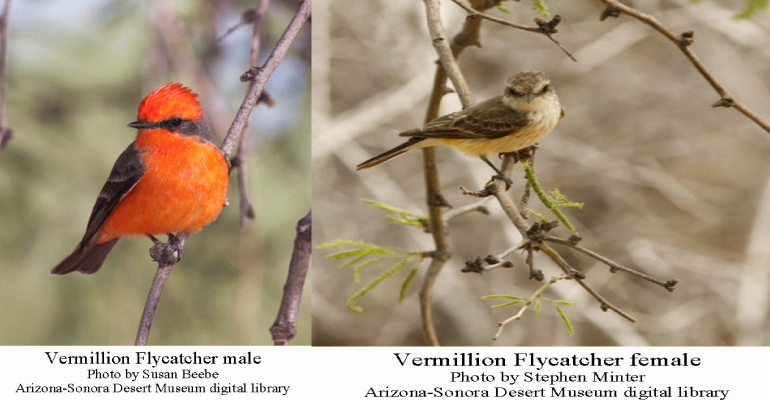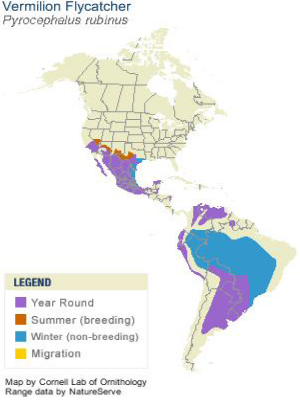
Vermilion flycatchers (Pyrocephalus rubinus) range from the southwestern U.S., through Mexico to South America. Several have been spotted recently in Tucson.
These are small birds, about 5 inches long. They inhabit desert scrub, cultivated lands, and riparian woodlands. The male has a brilliant red head and breast and a black mask, back and wings. The female is more subdued with a streaked white breast, brownish head and salmon or pinkish belly.
Vermilion flycatchers eat mainly insects. They perch in a tree and wait for something to fly into their range. They can take insects in mid-air.
According to the Arizona-Sonora Desert Museum:
“The male has a rather showy courtship display that involves fluffing up the feathers while rising vertically in the air and hovering, then swooping back to its perch or fluttering slowly to the female. The nest is built by the female in the horizontal fork of mesquite, willow or cottonwood, and other trees. The nest, which consists of twigs, grass and weeds, is lined with feathers or hairs and is often held together by spider webs. The two to four heavily spotted cream-white eggs take fourteen to fifteen days to incubate. Only the female incubates the eggs but both parents feed the young until they fledge at fourteen to sixteen days.”
According to the Cornell Lab of Ornithology:
 “The male Vermilion Flycatcher often seeks to initiate copulation by delivering a butterfly or other showy insect to the female. The male Vermilion Flycatcher performs a spectacular display, fluttering 10 to 30 meters (11-33 ft) above the canopy, singing. Sits and waits on an open perch, locates prey, and pursues it.” Listen to the call here.
“The male Vermilion Flycatcher often seeks to initiate copulation by delivering a butterfly or other showy insect to the female. The male Vermilion Flycatcher performs a spectacular display, fluttering 10 to 30 meters (11-33 ft) above the canopy, singing. Sits and waits on an open perch, locates prey, and pursues it.” Listen to the call here.
Cornell also notes that “twelve subspecies of Vermilion Flycatcher are recognized, including a race with a dark morph that ranges from western Peru to northern Chile. Both male and female of this morph are dark all over, with some males having a few red feathers on the head, and some females having a pinkish wash under the tail.”
There are many types of flycatchers. ASDM opines:
“Bird watchers are sometimes driven to despair by the challenge of telling the various flycatchers apart. Many of the species look virtually the same. Birds have to be able to recognize their own kind, of course, at least during the breeding season, but the flycatchers evidently do so mostly by voice. In the Sonoran Desert, for example, the Brown-crested and Ash-throated Flycatchers are almost identical except for size, but their songs and calls are different. Perhaps capitalizing on their need for vocal distinctions, many flycatchers have “dawn songs,” seldom heard later in the day.”
Vermilion flycatchers are in the Tyrannidae, or tyrant flycatcher family. They are called “tyrant” because they fiercely defend their nests and even drive larger birds away.
By the way, “Vermilion Flycatcher” is the name of the Tucson Audubon’s quarterly newsletter.
Note on spelling: is it vermilion with one L or vermillion with double L? Apparently both forms are used: the single L version comes from Middle English and the double L form comes from Anglo-French. I’ve always used the double L, but deferred to the spelling used by my sources for this article.
Related articles;
Cactus Wrens – Arizona’s very noisy state bird
Cardinals, Pyrrhuloxias and a cameo appearance by Phainopepla
Curve-billed Thrasher – a bold and inquisitive bird
Great Blue Herons in the desert
Nighthawks and Poorwills, birds of the night
Steller’s Jay – noisy and bold
Thick-billed Parrots in Arizona
Western Tanager – a flaming red-head‘
Note to readers: I have constructed a linked index to more than 300 of my ADI articles. You can see it at: https://wryheat.wordpress.com/adi-index/
You can read my comprehensive, 28-page essay on climate change here: http://wp.me/P3SUNp-1bq
